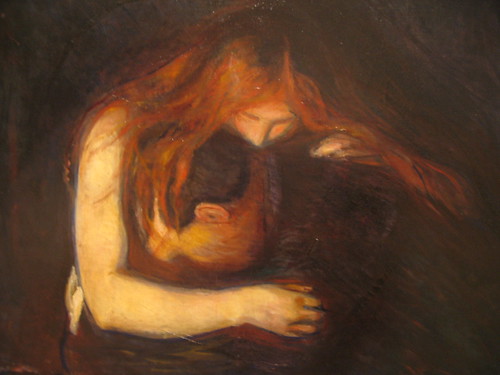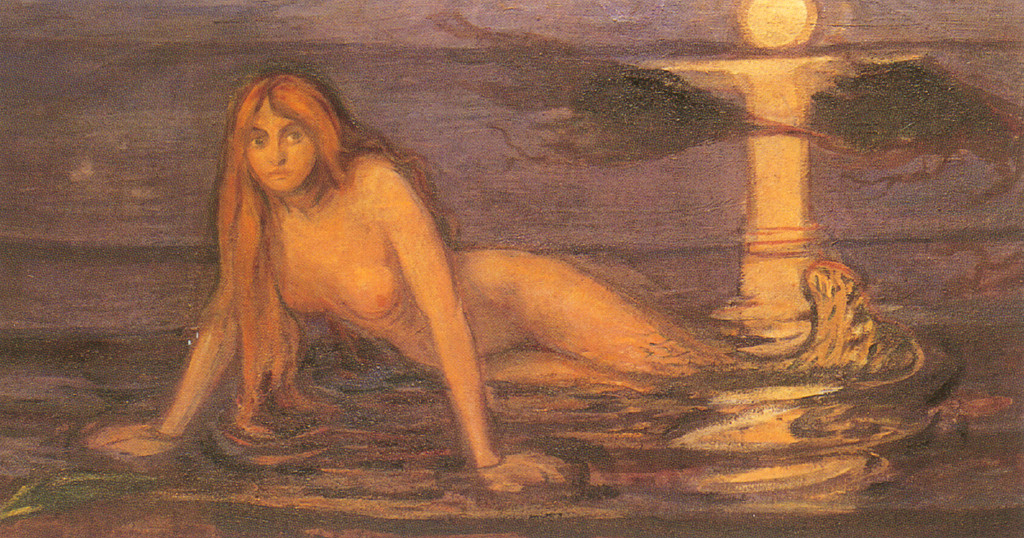
Shrick 呐喊

Madona

The sick child , Tate, London

One of several versions of the print "The Lonely Ones". The Munch Museet, Oslo, Norway.
Puberty 青春期

Sensous Vampires Kiss
The Kiss
爱德华·蒙克(Edvard Munch,1863年12月12日-1944年1月23日),挪威表现主义画家和版画复制匠。他对心理苦闷的强烈的,呼唤式的处理手法对20世纪初德国表现主义的成长起了主要的影响。
生平
童年
蒙克,1863年12月12日出生于挪威雷登(Løten),在克里斯蒂安尼亚(现在的奥斯陆)长大。是画家雅各布·蒙克(Jacob Munch)和历史学家彼得·安德烈·蒙克(Peter Andreas Munch)的亲戚。蒙克的母亲劳拉(Laura Cathrine Bjølstad)在1868年死于肺结核,母亲过世后年幼的蒙克由父亲单独抚养。其父患有精神疾病,他向孩子们灌输了对地狱根深蒂固的恐惧观念,他一再告诉孩子,如果他们在任何情况下以任何方式犯罪,就会注定被投入地狱,没有任何宽恕的机会。
父亲在蒙克青年期去世(1889年),另一个兄弟和蒙克最喜欢的姐姐苏菲在1877年也死了。蒙克的一个妹妹在小时候就被诊断出患有精神病,蒙克自己也是体弱多病。在五个兄弟姐妹中,只有兄弟安德烈结过婚,但婚后不过数月也过世了。眼见双亲和手足接二连三地死去,严重打击了蒙克的精神与情绪,接踵而至的悲伤对其是深度的精神折磨。因此,死亡烙印在他年轻而敏感的心灵深处,这大概就是为什么蒙克的作品呈现压抑且悲观的原因。蒙克在晚年说到:“病魔、疯狂和死亡是围绕我摇篮的天使,且持续的伴随我一生。”
青年时期
1879年,蒙克为了成为工程师而进入工学院念书。然而身体的健康不断出现问题,让他中断了学业。1880年蒙克为了成为画家而离开工学院。隔年他考进了奥斯陆皇家艺术和设计学院,他的老师是雕刻家朱利厄斯·米德尔顿(Julius Middelthun),以及自然主义画家克里斯蒂安·克罗格(Christian Krohg)。
1885年蒙克前往巴黎,他的作品也展现了自法国画家处所受到的影响。一开始是印象派,接着是后期印象派,然后是新艺术造型。蒙克的绘画尽管风格上是以后期印象派为主,但在主题上却是象征派,其绘画内容在于刻画内心世界,而不是外在现实。
1892年蒙克应邀参加柏林艺术家联盟在11月份举行的画展,他的绘画也成了争论的主题,为期一周的画展结束后,蒙克待在柏林,成为一个多国人士参与的社交圈其中一员,这个圈子里有作家、艺术家和评论家,包括挪威剧作家亨利克·易卜生(蒙克为易卜生的几个剧本设计布景),以及瑞典戏剧家奥古斯特·斯特林堡。
1892年至1908年间,蒙克多数时间都在巴黎和柏林度过,他因铜版画、石版画和木版画的表现成出名了。在世纪之交期间的柏林,蒙克开始用新的素材(照相、石版印刷和木版画),凭著记忆来复制他过去的作品。1908年秋,他的焦虑变得更为深刻,开始在丹尼尔·贾可布逊博士的诊所开始住院接受治疗。医院里施行的休克疗法改变了他的个性。
1909年,蒙克回到家乡挪威,更多地表现出对大自然的兴趣,他的作品变得更富于色彩,减少了悲观的成分。在纳粹统治期间,蒙克的作品被贴上了“颓废艺术”的标签,从德国的各个美术馆被撤了下来。这对反纳粹主义的蒙克来说是很伤心的,因为他把德国看作第二祖国。
晚年
蒙克在过完80岁生日后一个月的1944年1月23日,于奥斯陆附近的艾可利(Ekely)与世长辞。他捐赠了1000幅油画、15400张版画,4500件素描和水彩画,还有6件雕刻作品给予奥斯陆当局。为了纪念蒙克,当局建造了“蒙克美术馆”(位于Tøyen)。蒙克美术馆是全世界收藏蒙克作品为数最多的美术馆。
位于奥斯陆的国立艺术画廊,收藏了蒙克的一些油画作品。奥斯陆“大陆酒店”(Hotel Continental)里的“Dagligstuen”酒吧则藏有不少蒙克的版画精品。
画风
在蒙克的画家生涯中,他多次曾改变艺术风格。在1880年代,蒙克是自然派(比如《汉斯·耶格的肖像》)和半印象派(见《拉法耶特大街》)。1892年,蒙克树立了具个人特色的综合派原始画风(比如《忧郁》),在此色彩成为一种象征,亦是种具有承载功能的元素(比方说《呐喊》)。1890年代,蒙克倾向选择景深较浅的作画空间,他经常把画中的人物安置在前台。
蒙克一直想表现人物的内心的心理状态,出现在他画中的人物呈现了最能表现这种状态的姿势(见《灰烬》),这种安排让蒙克的画带来一种好像人物、空气、记忆、动作和时间在一霎刹那间凝固的感觉,那也许正是人物内心活动达到顶峰的一瞬间。
蒙克所画的人物,犹如舞台剧的各个角色(就像《病室里的死亡》),很可能每种特定的姿势就代表一种特定情绪,类似于某种身体语言。由于蒙克所画的人物都承担着表现一种特定心理状态的使命(以《呐喊》为最有名),所以他创造的男人和女人不是现实的。蒙克坚称,印象派并不适合于自己的艺术。他对描写现实的任意一个断面也不感兴趣,他要描写的是那种充满了情绪内涵的,且具有巨大的传神力的状态。为了达到这个目的,蒙克殚精竭虑地构思,他的作品创造了紧张气氛。
代表作品
呐喊
《呐喊》(挪威语Skrik,也译作《尖叫》,作于1893年),是蒙克最著名的代表作,被认为是存在主义中表现人类苦闷的偶像作品,和其他作品的惯例一样,他一共画了四个不同版本的《呐喊》。蒙克在世纪之交时期创作了交响乐式的《生命的饰带》(The Frieze of Life)系列,《呐喊》属于这个系列。这个系列涉及了生命、爱情、恐惧、死亡和忧郁等主题。
蒙克通过这些主题来表现他切身经历对生存和死亡的感受,比如《病中的孩子》(1886年,蒙克去世的姐姐苏菲的肖像画)、《病室里的死亡》(1893年)、《绝望》(1893-1894年)、《吸血鬼》(1893-1894年)、《焦躁》(1894年)、《灰烬》(1894年)、《生命之舞》(1900年),每幅画都强烈地传达画家的感觉和情绪,其描绘的对象的现实细节被简化,而情绪则被夸张,对象本身成为一种要表现的情绪的载体,虽然它们依然还是具象的。这些画具有永恒的震慑心灵的力量,在这一切的背后,观赏者还可以看见“世纪末”的景象,那种迷途的欲望深渊和无法逃脱的死亡阴影的怪圈,生命的焦躁和无奈交织在一起。
蒙克作品的惊人表现,力量是来自于对艺术家内心世界不加掩饰的忠实表达,蒙克的画是用整个心灵创作的。在1889年26岁的蒙克就写道:“我们将不再画那些在室内读报的男人和织毛线的女人,我们应该画那些活着的人。他们呼吸、有感觉、遭受痛苦并且相爱。”
生命的饰带
1893年12月,蒙克在柏林著名的菩提树下大街开画展。和其它作品一起,蒙克出展了题为“爱的研究系列”,由六幅画所组成。这是他此后命名为“生命的饰带”组画的起点。它包括深深地沉浸于大气的主题:《风暴》、《月光》和《星夜》。其它主题有揭示爱的阴暗面的,比如《玫瑰与阿美莉》和《吸血鬼》。《病室里的死亡》则以死亡为主题,基于蒙克对姐姐苏菲之死的回忆。在这幅画中,蒙克的全家都在到,画面的焦点聚集在蒙克的背影上。1894年,“生命的饰带”加进了《焦躁》、《灰烬》、《圣母》(Madonna)和《女人三阶段》作品集。在世纪之交之际,蒙克完成了他的“生命的饰带”组画系列。
蒙克的作品有不少,其中一部分反映了当时新艺术(art nouveau)的美学思潮。1898年,蒙克专为他的大型绘画《新陈代谢》(最初名为《亚当和夏娃》)做了一个带有浮雕装饰的精致的木制框架,这显露了蒙克对“人类的堕落”神话的偏爱和他在恋爱方面的悲观哲学。《空的十字架》和《受难之地》(Golgota)都作于1900年,既反映了当时的形而上学的倾向,又是蒙克幼年时代的虔诚心的反照。“生命的饰带”的第一次完整展出是在1902年柏林分离派画展上。
(wiki)
List of major works
- 1892 - Evening on Karl Johan
- 1893 - The Scream
- 1894 - Ashes
- 1894-1895 - Madonna
- 1895 - Puberty
- 1895 - Self-Portrait with Burning Cigarette
- 1895 - Death in the Sickroom
- 1899-1900 - The Dance of Life
- 1899-1900 - The Dead Mother
- 1940-1942 - Self Portrait: Between Clock and Bed
Gallery
The Scream. 1893. Oil, tempera, and pastel on cardboard. Nasjonalgalleriet, Oslo. | Death in the Sickroom. c. 1895. Oil on canvas. 59 x 66 in. Nasjonalgalleriet, Oslo. | The Dance of Life. 1899–1900. Oil on canvas, 49½ x 75 in. Nasjonalgalleriet, Oslo. | Madonna. 1894-95. Oil on canvas. 36 x 28 in. Nasjonalgalleriet, Oslo. |
Vampire. 1893-94. Oil on canvas. Nasjonalgalleriet, Oslo. | Ashes. 1894. Oil on canvas. 120.5 x 141 cm. Nasjonalgalleriet, Oslo. | The Sick Child (1885-87). Tate Gallery, London. | |
August Strindberg. 1892. Oil on canvas, 120 x 90 cm. Museum of Modern Art, Stockholm, Sweden |

‘I was out walking with two friends. The sun began to set. Suddenly the sky turned blood red. I paused, feeling exhausted, and leaned on the fence. There was blood and tongues of fire above the blue black fjord and the city. My friends walked on and I stood there trembling with anxiety, as I sensed an infinite scream passing through nature.’
The Scream, Edvard Munch’s most dramatic and important work, is a potent symbol of terror, but terror of what; an existential loneliness? – the death of God? – the meaninglessness of materialism? Whatever, Munch projects this unbearable dread and isolation into this painting.
But artists always project their innermost feelings into their work. All creative people do. So why was Munch so anguished? Was it the death of his mother from TB, the combination of love and fear he felt for his father, the death of his older sister from the same dread disease, his own brush with death, or his feelings of guilt and devastation from two failed love affairs? That’s enough trauma for anybody, particularly one as sensitive as Edvard Munch. Love and death dominate his work, but representations of love were never joyous; they were always linked in his art with threat and death. And it was his experience of home and family that provided the inspiration for his creative expression.
As he wrote, ‘When I cast off on the voyage of my life, I felt like a ship made of old, rotten material sent out into a stormy sea by its maker with the words. If you are wrecked, it’s your own fault and you will be burnt in the eternal fires of hell.’ Not the most inspiring message to set sail on.
Edvard Munch came from the bourgeois suburb of Christiania, just outside Oslo, a society redolent of protestant hypocrisy. The state controlled brothels were regularly inspected to ensure that their upright clients did not take VD back to their protestant wives. But the Munches were more bohemian; middle- class priests, scholars, artists and poets with elements of genius and degeneration. His father was an impoverished army doctor. His wife, Laura, was one of his patients and half his age, but she shared the same deep religious convictions. They had five children in seven years but it exhausted Laura. She died of TB when Edvard was just 5. Karen, Laura’s sister, brought a breath of fresh air into the family home. It was she who encouraged Edvard to draw. By the age of 12, he was spending many hours a day drawing. But Edvard’s father was not consoled by Karen; he sank into his own introspections and used to frighten the children with stories of Edgar Allen Poe and warnings that their mother was watching them. Edvard suffered from nightmares and nearly died of TB when he was 13, and the following year his elder sister, Johanna died.
But Edvard found solace in drawing and painting and confidence in his success. At 22 he exhibited his work at the World Fair in Antwerp and was embarking on an affair with a married woman. ‘Young and inexperienced from a monastery like home, knowing nothing of this mystery, I met a salon lady and stood before the mystery of women.’ No doubt this ‘education’ informed his depictions of women as vampires, creatures that would seduce, tempt and destroy men. ‘Behind the prettiness lies death; the medusa’s head.’ Whereas Ibsen was writing about the entrapment of women by marriage, Munch saw men as the victims.
In 1889 he went to Paris, where he came into contact with the Impressionists, but it was Van Gogh’s suicide that probably had the greatest impact on him. The shock opened up a space in Edvard’s painting. He came to believe that painting should not just be about representation, it should express those feelings, emotions, states that you couldn’t see.
‘People will understand what is sacred in them and will take off their hats as if in church I shall paint living people who breathe and feel and suffer and love’.
In 1892, Munch was invited to exhibit his paintings in Berlin, but his exhibition upset the sensibilities of the narrative, romantic style of German art. Munch painted it as it was. His Frieze of Life, depicted the trajectory of a love affair through the kiss, love, pain, jealousy, betrayal and despair. Painting for Munch did not express one moment, but could, like a poem or a novel, illustrate an unfolding narrative. The exhibition was withdrawn after a week. This pleased the entrepreneur in Munch immensely as he realised that the negative publicity would do him nothing but good.
But appeals to his darker needs were never far away. His relationship with Tulla Larson, the 30 year old unmarried daughter of a rich wine merchant was one from which neither would ever recover. He was shocked and frightened by the strength of Tulla’s passion. He expressed his regret that this on-off affair has robbed him of 3 years of creative life and the use of his left hand, which was wounded when his pistol was accidentally discharged during their final argument. Bereft and traumatised, he threw himself into excesses of work, drink and gambling. He became ill, paranoid, developed hallucinations and in 1908 broke down and was admitted to Dr Jacobsen’s clinic. In time, he recovered and carried on working until his death in 1944, though some said that the life, the intensity had gone out of his work.
Before I knew anything about Munch, I was using his images to illustrate my talks on the bodily expression of human emotion. His expressive paintings capture the anguish of emotion more clearly than any other artist I know. He was a man on a mission, a mission to discover meaning through the depiction of love, fear,melancholia and death. He believed that you had to spill your guts for art. So Munch made art from his life, his depressed sick childhood, the deaths of his mother and sister, his morbidly introspective father, his tortured romances. He marketed the flaws in his personality for people to recognise and identify with. He offended people, of course. Even Adolf Hitler regarded his work as degenerate art. With such enemies, however, he had no need of friends. His legacy was assured. His emotionally charged landscapes had launched the German expressionist movement while his ability to get under the skin to the raw bleeding core of his subjects inspired such contemporary masters as Frances Bacon and Lucian Freud.
Schopenhauer once wrote, ‘The limit of the power of art is its inability to reproduce a scream.’ Perhaps Munch wished to show him his error.









